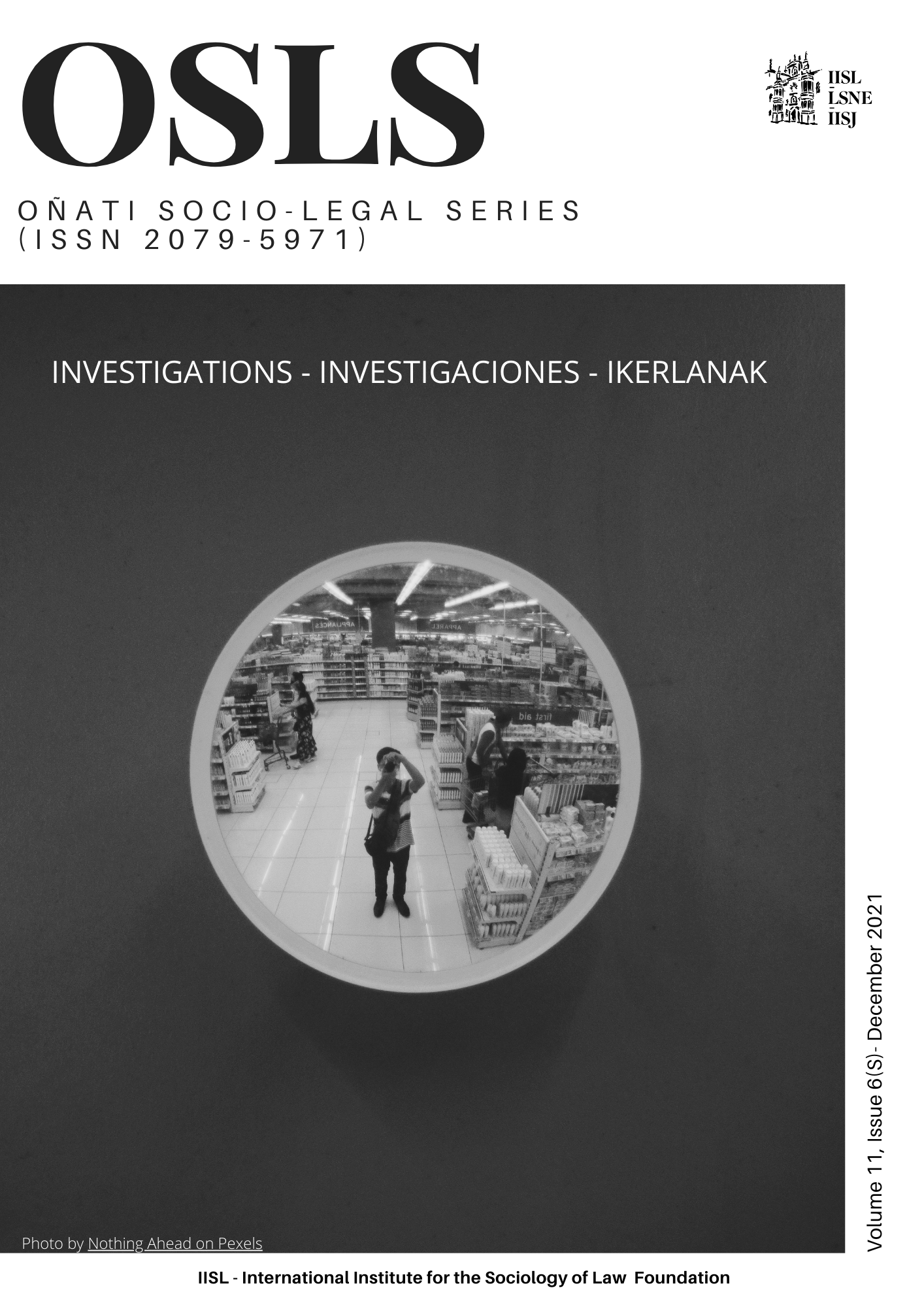Alcohol-related crime or no crime because of the perpetrator’s (factual) insanity?
DOI:
https://doi.org/10.35295/osls.iisl/0000-0000-0000-1203Keywords:
crime, insanity, state of intoxication, diminished sanity, guiltAbstract
The criminal liability of the perpetrator of a criminal act is not only conditioned on the objective features of the criminal act but also on the subjective ones (intentional or unintentional behavior). Apart from the subjective features of the act, guilt is also necessary in order to be able to attribute the crime. However, both theory and practice face with one exception to the principle of nullum crimen sine culpa (no crime without guilt). This applies to a state of disturbances of mental functions caused by the perpetrator of a criminal act. There are numerous problems arising from the collision of the need to punish the perpetrator (dictated by criminal policy), and the real state of his/her psyche, which can sometimes speak even for no fault (and thus no crime). It has a significant meaning for the subjective aspects of the crime. The aim of this study is to present these problems based on a dogmatic and legal analysis of regulations and a review of the literature in the field of medicine. The final conclusions lead to a de lege ferenda postulate concerning the legal solution of the above-mentioned dilemmas.
Downloads
Metrics
Global Statistics ℹ️
|
948
Views
|
399
Downloads
|
|
1347
Total
|
|
References
Brzezinska, J., 2007. Kilka uwag o istocie niepoczytalności [Some remarks on the essence of insanity]. In: L. Bogunia, ed., Nowa kodyfikacja prawa karnego, vol. 21, p. 21. Wroclaw.
Buchala, K., 1998. Wina czynu a zawinienie na przedpolu czynu zabronionego [w:] Aktualne problemy prawa karnego i kryminologii [The fault of the act and the guilt on the foreground of a prohibited act]. In: E. Pływaczewski, ed., Current problems of criminal law and criminology. Białystok: University of Białystok/C.H. Beck, pp. 77–78.
Glaser, S., 1934. Normatywna nauka o winie [Normative Wine Science]. Warsaw, pp. 3–4.
Golonka, A.D., 2013. Niepoczytalność i poczytalność ograniczona [Insanity and diminished sanity]. Warsaw: Wolters Kluwer, pp. 321–329.
Jelinek, E.M., 1946. Phases in the Drinking History of Alcoholics. Quarterly Journal of Studies on Alcohol [online], 7(1), pp. 1–88. Available from: https://doi.org/10.15288/QJSA.1946.7.1 [Access 5 May 2021]. DOI: https://doi.org/10.15288/qjsa.1946.7.001
Kaczmarek, T., 2005. Spory wokół pojęcia winy w prawie karnym [Disputes over the nature of responsibility]. In: L. Leszczyński, E. Skrętowicz and Z. Hołda, eds., W kręgu teorii i praktyki prawa karnego. Księga poświęcona pamięci profesora Andrzeja Wąska. Lublin: Maria Curie-Skłodowska University, p. 37.
Kocur, J., 1991. Wpływ alkoholu na stan emocjonalny. Aspekty sądowo- psychiatryczne [The influence of alcohol on the emotional state. Forensic-psychiatric aspects]. In: Z. Majchrzyk, T. Gordon and E. Milewska, eds., Materiały IX Krajowej Konferencji Sekcji Psychiatrii Sądowej PTP pt. Stany afektywne w opiniowaniu sądowym psychiatryczno-psychologicznym. Warsaw: PTP, pp. 129–130.
Kopera, M., Wojnar, M., and Szelenberger, W., 2010. Funkcje poznawcze, struktura i czynności mózgu u osób uzależnionych od alkoholu [Cognitive functions, structure and activities of the brain in people addicted to alcohol]. Alkoholizm i Narkomania, 23(4), pp. 361–378.
Lachowski, J., 2006. Przejawy obiektywizacji odpowiedzialności karnej w k.k. z 1997 r [Indications of the objectification of criminal liability in the Penal Code of 1997]. Studia Prawnicze [Legal Studies], 1(1), pp. 131–132. DOI: https://doi.org/10.37232/sp.2006.1.6
Mechtcheriakov, S., et al., 2007. A widespread distinct pattern of cerebral atrophy in patients with alcohol addiction revealed by voxel‐based morphometry. Journal of Neurology, Neurosurgery & Psychiatry [online], 78(6), pp. 610–614. Available from: https://doi.org/10.15288/QJSA.1946.7.1 [Access 5 May 2021]. DOI: https://doi.org/10.1136/jnnp.2006.095869
Pollock, V.E., et al., 1983. The EEG after alcohol administration in men at risk for alcoholism. Archives of General Psychiatry [online], 40(8), pp. 857–861. Available from: https://doi.org/10.15288/QJSA.1946.7.1 [Access 5 May 2021]. DOI: https://doi.org/10.1001/archpsyc.1983.01790070047006
Polska Policja, 2018. Wypadkidrogowe w 2018 roku [Road accidents in 2018]. Statystika [online]. Available from: https://statystyka.policja.pl/download/20/308515/Wypadki2018.pdf [Access 8 August 2020].
Polska Policja, 2020a. Nietrzeźwi sprawcy przestępstw [Drunk offenders]. Statystika [online]. Available from: http://statystyka.policja.pl/st/wybrane-statystyki/nietrzezwi-sprawcy-prz/50862,Nietrzezwi-sprawcy-przestepstw.html [Access 5 May 2021].
Polska Policja, 2020b. Przemoc w rodzinie - dane za lata 2012–2020 [Domestic violence – Data for the years 2021 to 2020]. Statystika [online]. Available from: https://statystyka.policja.pl/st/wybrane-statystyki/przemoc-w-rodzinie/201373,Przemoc-w-rodzinie-dane-od-2012-roku.html [Access 5 May 2021].
Vissers, L., Houwing, S., and Wegman, F., 2017. Alcohol-Related Road Casualties in Official Crash Statistics [online]. Research report. Paris: OECD/International Transport Forum (ITF). Available from: https://www.itf-oecd.org/sites/default/files/docs/alcohol-related-road-casualties-official-crash-statistics.pdf [Access 5 May 2021].
Wolter W., 1954. Wina w prawie karnym [Guilt in criminal law]. Warsaw: PWN, pp. 47–65, 78–79.
Zahr, N.M., and Pfefferbaum, A., 2017. Alcohol’s Effects on the Brain: Neuroimaging Results in Humans and Animal Models. Alcohol Research. Current Reviews [online], 38(2), pp. 183–206. Available from: https://www.ncbi.nlm.nih.gov/pmc/articles/PMC5513685/ [Access 5 May 2021].
Zoll, A., 2016. Kodeks karny. Komentarz. Część ogólna, t. I, Komentarz do artykułów 1–116 Kodeksu karnego. In: A. Zoll, ed., LEX, pp. 54–55.
Downloads
Published
How to Cite
Issue
Section
License
Copyright (c) 2021 Anna Danuta Golonka

This work is licensed under a Creative Commons Attribution-NonCommercial-NoDerivatives 4.0 International License.
OSLS strictly respects intellectual property rights and it is our policy that the author retains copyright, and articles are made available under a Creative Commons licence. The Creative Commons Non-Commercial Attribution No-Derivatives licence is our default licence and it regulates how others can use your work. Further details available at https://creativecommons.org/licenses/by-nc-nd/4.0 If this is not acceptable to you, please contact us.
The non-exclusive permission you grant to us includes the rights to disseminate the bibliographic details of the article, including the abstract supplied by you, and to authorise others, including bibliographic databases, indexing and contents alerting services, to copy and communicate these details.
For information on how to share and store your own article at each stage of production from submission to final publication, please read our Self-Archiving and Sharing policy.
The Copyright Notice showing the author and co-authors, and the Creative Commons license will be displayed on the article, and you must agree to this as part of the submission process. Please ensure that all co-authors are properly attributed and that they understand and accept these terms.






















